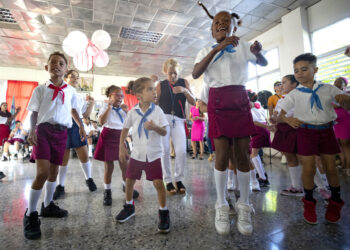The time Nielsis Ramírez dedicates to knitting is sacred. “My husband and my son know this. I come home from work, start cooking and set to work on fraying until the Newscast begins on TV.”
With almost half a century dedicated to needlework, this Trinidad woman who doesn’t have a noble ancestry affirms to the letter that the history of the township that the Spaniards founded in the center of Cuba more than 500 years ago could be written through verses and intricacies, because between the very fine threads confined in the embroidering ring lives one of the autochthonous traditions of greatest excellence in the country: lace trimming.
Like the other inhabitants of the city, Nielsis learned from her grandmother, who in turn was taught by her great-grandmother, since for centuries the oral tradition was the only means of learning crafts works.
These practices come from Spain. At the beginning they were only for the young ladies from the social elite; already by February 1587 a merchant called Cristóbal Martel included in his offers homemade threads and fine fabrics. The exact data, however, remains like loose threads that can’t be basted.

What today is one of Trinidad’s principal credentials was conceived in the salons of the 19th-century mansions. Paradoxically, the moment in which it was expanded outside the noble spaces did not take place in the stage of splendor but rather in the heat of the economic ruin the city lived in the mid-19th century.
Due to the instinct of survival, need and experimenting to deal with the decadence that reigned overnight, the women who previously served the sugar aristocracy saw in the needles a source of subsistence that, while it didn’t report great benefits, at least served to guarantee the day-to-day family economy.
The thousands of craftswomen who today dot the commercial areas of Trinidad’s Historic Center and of Manaca Iznaga – a dream sugar mill built in the heart of the Valle de los Ingenios – know little of such historiographical questions, but thanks to them the so-called Museum City of the Caribbean weaves the face of its immaterial heritage.
While each designer builds her own handbook, they all coincide with two indispensable requirements when “drawing” with needles: patience and good memory.

The quality and mastery of the works depend on the first. The real lace trimming, the authors insist, is that made with the same thread that is taken out of the fabric from which the piece is produced, although at present colors have been incorporated to the white sheets.
That is why each creation is a work of art that, according to the size and complexity, can take up to 21 days to finish. Such work, on the other hand, at times is not paid well; at others, it is. It all depends on the laws dictated by the tourism season and the daily urgent needs.
A good memory, on the other hand, guarantees to learn the name and algorithm to make more than 50 lace trimming needlepoints. Ojito de la perdiz, barahúnda, avispero, solecito, enrejado, lace insert, jasmine with fabric, spit curl, coil…are just a sample of the wonders that can be made with the turns, skills and actions of the needle on the frame.
The one most sought by the buyers, according to experts, is the Trinidad stitch, a very typical needlepoint which reproduces images of the colonial grillwork, an initiative of the township’s embroiderers, an evolutionary step whose date has been lost in time.
Belén González de León, a woman from Valencia visiting the town, has just bought a tablecloth with 10 napkins at an outlet located close to the Plaza Mayor. “I had some references of the wonders made here, but seeing them firsthand surpasses all expectations. This tablecloth, for example, reminds me a lot of what the older people in my family used to do. It has an exquisite finish, a very delicate and elegant design, but in addition, one perceives the centuries-old history behind the product. As a tourist, I consider myself fortunate seeing that this tradition is kept alive. That’s what we came in search of: getting to know what is typical of places in Cuba.”

The landscape of needles in Trinidad has also received the bonanzas of the island’s opening to new forms of non-state work, while today the historic center has private spaces where pieces of high aesthetic value are exhibited for a more demanding public. In addition, renowned craftswomen in the township have promoted courses and workshops for the city’s apprentices and the rural communities.
“Many people make a living from this, I’m not going to deny it, but it is also a question of a spiritual satisfaction,” Nielsis Ramírez confesses. “You’re not talking to an expert. I’m a woman from the barrio, a Trinidad woman like any other, but when I sit down with the ring and start fraying I drift away, I relax, I feel like a lady yesteryears,” she jokes.
In a gesture of openness, Nielsis looks at the clock. Outside the sun has started going down. Nielsis says she is about to serve dinner; a subtle way of reminding me that our conversation has ended because after cooking she will again enter the sacred space of the warp.











Me gustaría mucho poder contactar con Nielsis, me dejan su contacto por favor.